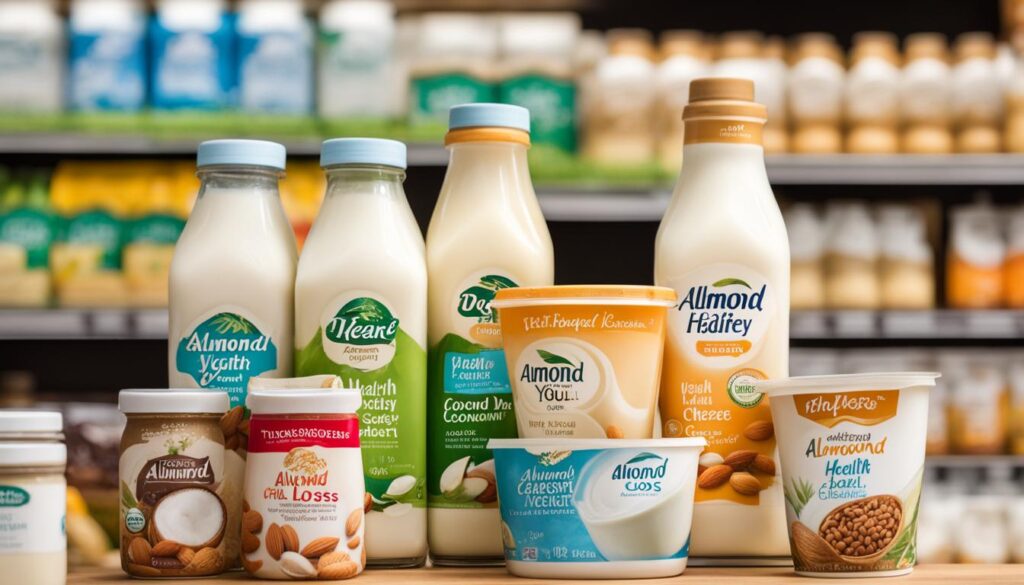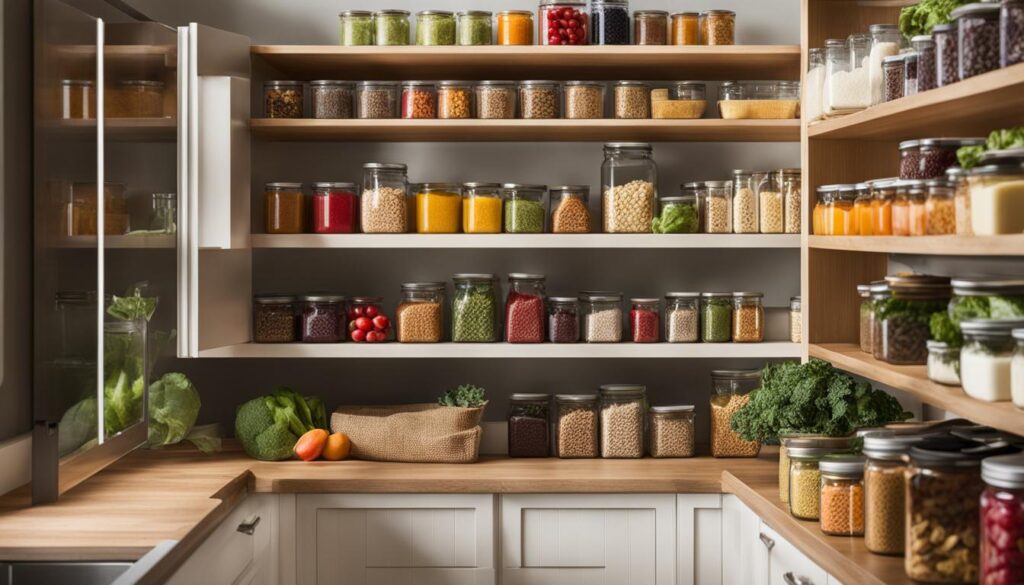When it comes to weight loss, making sustainable and smart choices at the grocery store can be a game-changer. By adopting healthy eating habits and learning some grocery shopping tips, you can nourish your body while achieving your weight loss goals.
As a nutrition expert, I have witnessed firsthand the impact of sustainable weight loss through smart grocery shopping. Prioritizing nutritious foods, planning ahead, and being mindful of your choices can make a significant difference in your weight loss journey.
So, how can you master the grocery store and make weight loss a sustainable and achievable goal? In this article, I will share valuable nutrition tips, grocery store hacks, and weight loss strategies to help you navigate the aisles with confidence.
Key Takeaways:
- Mastering the grocery store is essential for sustainable weight loss.
- Prioritize nutritious foods like fruits, vegetables, whole grains, lean proteins, and low-fat dairy or dairy alternatives.
- Create a grocery list based on complete meals and healthy snacks to save time and prevent impulse purchases.
- Shop for items in specific sections within the store to make your shopping experience more efficient.
- Choose high-quality, minimally processed foods to maximize nutrient intake.
Prioritizing Fruits and Vegetables for Weight Loss
When it comes to weight loss, fruits and vegetables should be at the top of your grocery list. These nutrient-packed foods not only contribute to weight management but also provide essential vitamins, minerals, and fiber for overall health. By choosing a variety of produce in different colors, you can ensure that you’re getting a wide range of nutrients to support your weight loss journey.
To make the most of your fruit and vegetable shopping, opt for fresh, in-season produce whenever possible. Not only will you enjoy the best flavors, but you’ll also find more affordable prices. Incorporating seasonal fruits and vegetables into your shopping list ensures freshness and variety in your meals and snacks.
Additionally, it’s beneficial to stock up on canned and frozen fruits and vegetables without added sugars or sodium. These options have a longer shelf life and can be a convenient way to have nutritious ingredients on hand. Minimally processed options like pre-cut vegetables and roasted nuts/seeds can also save you time in the kitchen without sacrificing nutrition.
To better visualize the nutritional benefits of fruits and vegetables for weight loss, refer to the table below:
| Fruit | Nutritional Benefits |
|---|---|
| Apples | Rich in fiber and antioxidants, helps regulate blood sugar levels |
| Berries (strawberries, blueberries, raspberries) | High in antioxidants, low in calories, and promote satiety |
| Avocados | Healthy fats, fiber, and essential nutrients for heart health |
| Oranges | High in vitamin C, promotes immune function and collagen production |
Remember, fruits and vegetables not only aid in weight loss but also contribute to overall well-being. Make them a priority during your grocery shopping trips for a healthier and more nourishing diet.
Making Whole Grains a Staple in Your Diet
Incorporating whole grains into your diet is essential for weight loss and overall health. Whole grains are packed with nutrients, including dietary fiber, protein, and essential vitamins and minerals. They provide sustained energy and help you feel full, making them a valuable addition to your healthy eating plan.
When grocery shopping, be sure to choose whole-grain versions of bread, cereal, rice, and pasta whenever possible. Look for items where whole grains are listed as the first ingredient on the packaging. This ensures that you are getting the maximum benefits of whole grains while minimizing the intake of refined grains.

Additionally, don’t hesitate to explore “ancient grains” like quinoa, amaranth, and millet. These grains offer a variety of flavors and textures, adding excitement to your meals and snacks. Incorporate staple options such as brown rice, whole-wheat spaghetti, and oatmeal into your diet. These versatile whole grains can be used in a wide range of recipes to suit your preferences.
For busy individuals, quick-cooking grains like quinoa or rice can be convenient options. They require less time to prepare while still providing the health benefits of whole grains. Including whole grains in your diet supports weight loss and boosts overall health, making them an essential component of your grocery shopping list.
Key Points:
- Incorporate whole grains into your diet for weight loss and overall health.
- Choose whole-grain versions of bread, cereal, rice, and pasta.
- Opt for items where whole grains are listed as the first ingredient.
- Experiment with “ancient grains” like quinoa, amaranth, and millet.
- Include staple options such as brown rice, whole-wheat spaghetti, and oatmeal.
- Look for quick-cooking grains like quinoa or rice for convenience.
Select Lean Proteins for Optimal Weight Loss
When it comes to weight loss and building a healthy diet, choosing lean proteins is essential. Incorporating lean protein sources into your meals can help you feel satisfied and support your weight loss goals. Here are some grocery shopping tips to help you include lean proteins in your diet.
Opt for Lean Cuts of Meat
If you prefer meat-based proteins, opt for lean cuts such as skinless chicken breasts or turkey breast. These lean meats are low in fat and high in protein, making them ideal choices for weight loss. Consider purchasing family-sized or value packs of meat, as they are often more affordable. Freeze any excess meat to prevent waste and have it readily available for future meals.
Explore Plant-Based Proteins
If you follow a plant-based or vegetarian diet, there are plenty of options for obtaining lean proteins. Beans, lentils, and peas are affordable plant-based protein sources that are also rich in fiber. These versatile ingredients can be used in a variety of dishes, including soups, stews, and salads. In addition to providing protein, they offer essential nutrients that can support overall health and weight loss.
Incorporate Fatty Fish
While it might seem counterintuitive to include fatty fish in a weight loss diet, certain types, such as salmon, provide heart-healthy omega-3 fatty acids. These fats have been shown to have numerous health benefits, including supporting weight management. Aim to include fatty fish in your grocery shopping list to reap these nutritional benefits.
Don’t Forget About Eggs
Eggs are a versatile and budget-friendly source of protein. They contain essential amino acids and are rich in nutrients like vitamins D and B12. Consider including eggs in your diet, whether scrambled for breakfast, hard-boiled for a snack, or as an ingredient in various recipes.
| Lean Protein Options | Benefits |
|---|---|
| Chicken breast | High in protein, low in fat |
| Turkey breast | Lean source of protein |
| Beans, lentils, and peas | Affordable plant-based protein options |
| Salmon | Provides heart-healthy omega-3 fatty acids |
| Eggs | Versatile and budget-friendly protein source |
By selecting lean proteins like chicken, turkey, plant-based options, fatty fish, and eggs, you can optimize your weight loss journey while still enjoying delicious and nutritious meals.
Prioritizing Dairy and Dairy Alternatives
When it comes to weight loss, incorporating dairy or dairy alternatives into your diet can provide essential nutrients to support your goals. Here are some tips for making smart choices in the dairy aisle:
Choose Low-Fat or Fat-Free Options
Opt for low-fat or fat-free versions of milk, yogurt, and cheese. These options can help reduce calorie intake while still providing the protein, calcium, and other important vitamins and minerals found in dairy products.
Consider Non-Dairy Alternatives
If you prefer a non-dairy option, consider calcium-fortified soy milk. It can be a suitable alternative to cow’s milk, providing similar nutrients without the lactose. Just be sure to read the labels and choose unsweetened varieties to avoid unnecessary added sugars.
Check Yogurt Labels
When selecting yogurt, be mindful of added sugars in flavored varieties. Instead, choose plain yogurt and add your own flavors with fresh fruits and nuts. This allows you to control the sweetness while still reaping the benefits of this dairy staple.

Embrace the Versatility of Dairy Alternatives
Dairy alternatives, such as soy, almond, or oat milk, can be used in a variety of recipes and are great options for individuals with lactose intolerance or those following a vegan lifestyle. Experiment with different dairy-free alternatives to find the one that suits your taste and dietary preferences.
Enjoy the Benefits of Dairy
Dairy products are not only a good source of protein and calcium but also provide other important vitamins and minerals. Including dairy or dairy alternatives in your diet can help support bone health, aid in muscle recovery, and contribute to overall nutrient intake.
| Dairy Product | Benefits |
|---|---|
| Milk | Good source of protein, calcium, and vitamin D |
| Yogurt | Provides probiotics for gut health and additional vitamins and minerals |
| Cheese | Contains protein, calcium, and other essential nutrients |
| Non-Dairy Alternatives | Offer similar nutrients as dairy with options for individuals with lactose intolerance or vegan diets |
Remember to consider your individual dietary needs and preferences when choosing between dairy and dairy alternatives. The key is to prioritize options that align with your goals while still providing the necessary nutrients for a successful weight loss journey.
Making Smart Choices in the Grocery Store Aisles
When it comes to weight loss, making smart choices in every aisle of the grocery store is crucial. By selecting the right foods, you can support your goals for healthy eating and shed those extra pounds. Here are some grocery shopping tips to help you make intelligent decisions:
1. Opt for Fresh Produce, Frozen Fruits, and Vegetables
Start your journey to weight loss by prioritizing fresh produce. Fill your cart with a variety of colorful fruits and vegetables. They are packed with essential vitamins, minerals, and fiber, making them excellent choices for weight management. Additionally, consider adding frozen fruits and vegetables to your shopping list. They can be just as nutritious as fresh options and have a longer shelf life, allowing you to have a variety of healthy ingredients on hand at all times.
2. Compare Prices and Choose Budget-Friendly Options
Being conscious of your budget is important while grocery shopping for weight loss. Take the time to compare prices and select the most cost-effective options. Look out for sales, promotions, and discounts to maximize your savings. By being mindful of your spending, you can maintain a healthy diet without breaking the bank.
3. Look for Low-Sodium and No-Added-Salt Canned Vegetables and Fruits
When choosing canned vegetables and fruits, opt for low-sodium or no-added-salt options. These products provide the same nutritional benefits as fresh produce and can become pantry staples. Additionally, select fruits that are canned in 100% fruit juice to avoid added sugars. By making these smart choices, you can enjoy the convenience of canned produce while still prioritizing your weight loss goals.
4. Choose Whole-Grain Options in the Bread, Cereal, and Pasta Aisles
Whole grains are essential for a healthy diet and weight loss. They are rich in fiber, vitamins, and minerals, providing long-lasting energy and keeping you satiated. When shopping in the bread, cereal, and pasta aisles, opt for whole-grain options. Check the labels and choose products where “whole grains” are listed as the first ingredient. This helps ensure that you’re consuming the maximum amount of nutrients and fiber.
5. Explore Protein Sources in the Meat, Frozen Foods, and Dairy Sections
Protein is an important component of any weight loss plan, as it helps build lean muscle and keeps you full for longer periods. Explore different protein sources throughout the grocery store, including lean meats, frozen foods, and dairy products. Choose lean cuts of meat like chicken and turkey, and consider adding plant-based proteins like beans, lentils, and tofu to your cart. Incorporating a variety of protein sources ensures a well-rounded and balanced diet.
6. Select Low-Fat or Fat-Free Dairy Products
If you consume dairy products, opt for low-fat or fat-free options. These choices provide essential nutrients like calcium and protein without the added fat and calories. Consider selecting low-fat milk, yogurt, and cheese. Alternatively, you can explore dairy alternatives like soy milk or almond milk, which are often fortified with similar nutrients. Prioritizing low-fat or fat-free dairy products is a smart choice for weight loss and overall health.
7. Avoid the Chip and Cookie Aisles
When grocery shopping for weight loss, it’s best to avoid the chip and cookie aisles altogether. These aisles are filled with tempting but unhealthy snacks that can derail your progress. By steering clear of these aisles, you can save both money and calories. Instead, focus on selecting nutritious snacks like fresh fruits, yogurt, or nuts from other sections of the store.
Making smart choices in the grocery store aisles is essential for achieving your weight loss goals. By prioritizing fresh produce, comparing prices, looking for low-sodium options, choosing whole grains, exploring different protein sources, selecting low-fat or fat-free dairy products, and avoiding unhealthy snack aisles, you can make strides towards a healthier you.
Understanding Unit Prices for Savvy Shopping
When it comes to grocery shopping, understanding unit prices is a savvy way to make informed decisions and save money. Unit prices provide the cost per unit of measurement, allowing you to compare products and choose the most budget-friendly options. By comparing unit prices, you can identify the better deal, ensuring that you get the most value for your money.
Let’s take a closer look at unit prices and how they can help you with your grocery shopping:
What is a Unit Price?
A unit price is the cost of a single item divided by its unit of measurement. For example, if a box of cereal costs $3.99 and contains 16 ounces, the unit price would be $0.25 per ounce. This allows you to compare the prices of different sizes or brands and determine which offers a better value.
Comparing Unit Prices
When comparing unit prices, it’s important to consider factors such as package sizes and quantities. Sometimes, larger containers have a lower unit price, providing more value for your money. However, if the larger quantity is more than you need or can consume before it spoils, it may not be the most cost-effective option.
Here’s an example to illustrate how comparing unit prices can help you save:
| Product | Package Size | Price | Unit Price |
|---|---|---|---|
| Brand A Granola Bars | 8 bars | $2.99 | $0.37 per bar |
| Brand B Granola Bars | 12 bars | $3.99 | $0.33 per bar |
In this example, even though Brand B Granola Bars have a slightly higher price, the unit price is lower, making it the more budget-friendly choice.
Using Unit Prices Effectively
To make the most of unit prices, it’s essential to compare similar products. For example, if you’re deciding between two different brands of pasta sauce, compare the unit prices based on ounces or milliliters. This will help you determine which brand offers the most cost-effective option.
Additionally, keep in mind that unit prices can vary based on sales or promotions. Be sure to check the unit prices regularly, as the best deal may change over time.

By understanding and using unit prices to your advantage, you can become a savvier shopper, make informed decisions, and save money on your grocery bills.
Seasonal Produce Guide for Cost-Effective Shopping
Shopping for seasonal produce is not only a fantastic way to enjoy a variety of fresh flavors, but it can also be a cost-effective strategy for your grocery shopping. Throughout the year, different fruits and vegetables are in season, offering lower prices and optimal taste. By incorporating seasonal produce into your meals and snacks, you can experience the benefits of both freshness and savings.
Let’s take a look at some examples of seasonal produce during different times of the year:
Spring:
- Apples
- Asparagus
- Avocados
- …and more!
Summer:
- Watermelon
- Peaches
- Bell peppers
- Cucumbers
Fall:
- Grapes
- Pumpkins
- Acorn squash
- Persimmons
Winter:
- Clementines
- Oranges
- Pomegranates
- Sweet potatoes
By keeping an eye out for these seasonal options, you can not only enjoy the best flavor but also benefit from the lower prices. Whether you’re looking for ingredients to use in salads, smoothies, or main dishes, incorporating seasonal produce can bring a burst of freshness to your meals while keeping your wallet happy.
So next time you go grocery shopping, explore the seasonal produce section and embrace the variety of options available. Your taste buds and your budget will thank you!
Stocking a Healthy Pantry for Quick and Easy Meals
When it comes to creating quick and easy meals that support weight loss, stocking a healthy pantry is key. By keeping essential pantry staples on hand, you can easily whip up nutritious dishes without spending too much time in the kitchen. Here are some pantry items that should be a part of your healthy pantry:
- Oats: High in fiber and versatile, oats are perfect for breakfast or adding to baked goods.
- Whole-grain ready-to-eat cereals: Choose cereals that are low in sugar and high in fiber for a quick and filling breakfast option.
- Canned beans and lentils: These legumes are packed with protein and fiber, making them a great addition to salads, soups, and stews.
- Tuna/salmon/sardines: Canned fish is a convenient source of lean protein and omega-3 fatty acids, perfect for salads or sandwiches.
- Canned tomatoes: These are a versatile base for many dishes, such as pasta sauces, soups, and chili.
- Whole-grain pasta: Opt for whole-grain versions for added fiber and nutrients.
- Peanut butter: A great source of healthy fats and protein, peanut butter is perfect for spreading on toast or adding to smoothies.
- Various oils: Stock your pantry with healthy oils like olive oil and coconut oil for cooking and salad dressings.
- Spices: Having a variety of spices on hand can add flavor to any dish without adding extra calories.
These pantry staples are not only nutritious but also versatile. They can be combined in different ways to create a variety of quick and easy meals that support your weight loss goals. When your pantry is well-stocked, you don’t have to rely on unhealthy takeout or processed foods. Instead, you can confidently prepare delicious and healthy options right at home.
Remember to check the expiration dates of your pantry items regularly and replace them as needed to ensure the freshness and quality of your meals.

Having a well-stocked pantry is like having your own mini-grocery store at home. It allows you to quickly put together meals and snacks that align with your weight loss goals. By keeping these pantry staples on hand, you’ll always have the ingredients you need to create nutritious dishes without much effort.
Strategic Shopping Tips for Efficiency and Savings
Being organized and strategic while shopping can save you time, money, and unnecessary purchases. Here are some essential shopping tips to help you streamline your grocery trips and maximize your budget:
- Create a master list: Develop a comprehensive list of frequently purchased items to minimize the time spent wandering the aisles. This list will serve as a foundation for your shopping trips, ensuring that you don’t forget any essential items and helping you stay focused on your needs.
- Check your inventory: Before heading to the store, assess the contents of your fridge, freezer, and pantry. By knowing what you already have, you can avoid overbuying and prevent food waste. This also allows you to prioritize items that are running low and need to be replenished.
- Utilize meal-planning apps: Take advantage of technology by using meal-planning apps that generate convenient shopping lists based on your selected recipes and additional items. These apps can save you time and effort in creating a comprehensive list that covers all your needs.
- Organize your list: Arrange your shopping list according to your store’s layout. By structuring your list based on the store’s sections, you can minimize backtracking and navigate through the store more efficiently. This simple trick can help you save precious time.
- Shop during off-peak hours: Choose less busy times to shop whenever possible. Shopping during quieter periods allows for a more relaxed experience, as you’ll encounter shorter lines, uncluttered aisles, and greater shopping efficiency.
- Review past orders when shopping online: If you prefer online grocery shopping, take advantage of the convenience it offers. Reviewing your past orders can help you stick to your favorite and necessary items, avoiding unnecessary purchases and keeping your budget in check.
Remember, strategic shopping isn’t just about finding the best deals; it’s about making intentional choices to meet your needs and goals while maintaining a budget-friendly approach.
By implementing these shopping tips, you can optimize your grocery shopping experience, saving both time and money without compromising on your nutritional needs.
Smart Online Shopping for Convenience and Nutrition
When it comes to grocery shopping, online shopping offers a convenient and budget-friendly option. With just a few clicks, you can have your groceries delivered right to your doorstep, saving you time and energy. But how can you ensure that you make smart choices for your health and budget while shopping online?
Here are some tips to help you navigate the world of online grocery shopping:
- Review your past orders: Take a look at your previous orders to remind yourself of the items you may need. This can help you create a more comprehensive and efficient shopping list.
- Create a list and stick to it: Before you start browsing, make a list of the items you actually need. Stick to your list to avoid adding unnecessary items to your virtual cart.
- Take advantage of online coupons or discounts: Many online grocery stores offer special discounts and coupons that can help you save money. Be sure to look for these promotions before checking out.
- Choose a reputable online store: Selecting a reputable online store with good customer reviews can give you peace of mind and ensure that you’re purchasing quality products.
By following these tips, you can make the most of online grocery shopping by saving time, energy, and money, all while making smart choices for your health.
Do you want to see how online grocery shopping can be a game-changer? Have a look at this example:
“Online grocery shopping has completely revolutionized the way I shop for food. Not only is it incredibly convenient, but I also find that I make healthier choices because I’m not tempted by all the unhealthy snacks and treats at the store. Plus, I love that I can easily compare prices and take advantage of online discounts. It’s a win-win!”
Conclusion
To successfully achieve weight loss and maintain a healthy lifestyle, it is crucial to master the art of grocery shopping. By adopting sustainable and smart shopping habits, you can make informed decisions that prioritize your health and wellbeing.
When planning your meals, make sure to prioritize nutritious foods such as fruits, vegetables, whole grains, lean proteins, and low-fat dairy or dairy alternatives. These food groups provide essential nutrients while supporting weight loss.
Create a grocery list based on your meal plan and choose items based on sections within the store. This will help save time and prevent impulse purchases. Don’t forget to take advantage of seasonal produce for optimal freshness, flavor, and cost savings.
Stock up on pantry staples like whole grains, canned beans, and lean proteins. Having these items on hand will allow you to easily prepare quick and healthy meals. Additionally, following strategic shopping tips, such as understanding unit prices and avoiding unnecessary purchases, can help you save money and time.
By prioritizing nutritious foods, making informed decisions, and adopting sustainable shopping practices, you can achieve sustainable weight loss and maintain a healthy lifestyle. Start implementing these grocery shopping tips today and enjoy the benefits of improved health and wellbeing.
FAQ
Why should I prioritize fruits and vegetables for weight loss?
Fruits and vegetables are low in calories and high in nutrients, making them essential for weight management. They provide essential vitamins, minerals, and fiber to support a healthy diet.
How can I incorporate whole grains into my weight loss diet?
Choose whole-grain versions of bread, cereal, rice, and pasta. Experiment with “ancient grains” like quinoa, amaranth, and millet. Include brown rice, whole-wheat spaghetti, and oatmeal as staple options.
What are some options for lean proteins that can aid in weight loss?
Opt for lean cuts of meat like chicken and turkey. Consider plant-based proteins like beans, lentils, and peas. Include fatty fish like salmon for heart-healthy omega-3 fatty acids.
Can dairy or dairy alternatives be part of a weight loss diet?
Yes, choose low-fat or fat-free versions of milk, yogurt, and cheese. Consider calcium-fortified soy milk if you prefer a non-dairy option. Use low-fat plain yogurt as a base and add your own flavors with fruits and nuts.
How can I make smart choices in the grocery store aisles?
Opt for fresh produce, frozen fruits and vegetables, and whole grains in the produce section. Compare prices and choose budget-friendly options. Look for low-sodium or no-added-salt canned vegetables and fruits canned in 100% fruit juice.
How can I understand unit prices to save money while grocery shopping?
Compare unit prices to identify the better deal. For example, larger containers may have a lower unit price, providing more value for your money. Use unit prices to compare similar products and choose the most cost-effective options.
Are there benefits to shopping for seasonal produce?
Yes, shopping for seasonal produce can be cost-effective and provide a wide range of fresh flavors. Different fruits and vegetables are in season throughout the year, offering lower prices and optimal taste.
What should I stock in my pantry for healthy meals and snacks?
Keep pantry staples like oats, whole-grain ready-to-eat cereals, canned beans, tuna/salmon/sardines, canned tomatoes, and whole-grain pasta. Add items like peanut butter, various oils, and spices for flavor.
How can I be strategic while grocery shopping to save time and money?
Create a master list of frequently purchased items and check your fridge, freezer, and pantry to avoid overbuying. Make a shopping list based on your recipes and organize it according to your store’s layout. Shop during less busy times for a more relaxed experience.
Can online grocery shopping be a convenient and budget-friendly option?
Yes, online grocery shopping offers convenience and can help you stick to your list and avoid unnecessary purchases. Take advantage of online coupons or discounts and choose a reputable online store with good customer reviews.
How can I master the grocery store to support sustainable weight loss?
Prioritize nutritious foods, plan your meals, create a grocery list, and choose items based on sections within the store. Take advantage of seasonal produce, stock up on pantry staples, and follow strategic shopping tips to save money and time.


[…] valuable insights and strategies on how to optimize your meal prep routine. From meal planning to smart grocery shopping and ingredient prepping, these tips will help you save time, reduce stress, and prioritize your […]